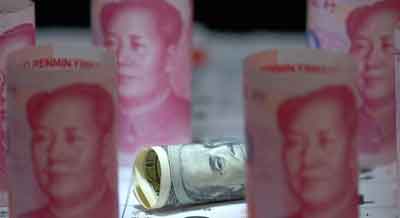China Accelerates Global De-Dollarization
Peter Reagan
 China’s U.S. Treasury holdings recently fell to 14-year low of $859 billion. China’s U.S. Treasury holdings recently fell to 14-year low of $859 billion.
According to a recent South China Morning Post explanation, this is not an accident – but rather a deliberate policy decision:
Reducing investments in Treasuries, a key component of Chinese foreign reserves, has been widely seen as among Beijing’s efforts to diversify its portfolio, lower dependence on the U.S. dollar while promoting the broader international use of the Chinese yuan and guard against the risk of sanctions, such as those imposed on Russia for its invasion of Ukraine.
The declining Treasuries investment is also read as a sign of Beijing’s unease with Washington’s financial policies. [emphasis added]
China’s hoard of U.S. Treasury bonds has slumped by a shocking 35% since July 2017.
Note: Why does this matter? Although the federal government sometimes seems to forget this, multi-trillion-dollar budget deficits have to be financed by somebody. Every year since 2001, the federal government has spent more money than it’s collected. In order to finance the spending, the Treasury Department issues IOUs called Treasury bonds and sells them on the open market. Individual investors and nations, from Albania to Vatican City, buy them. And the government finances deficit spending with their cash.
This is a story about China, one of the federal government’s biggest creditors, deciding that maybe U.S. government IOUs aren’t such a great investment after all.
Why? China Daily is happy to explain:
…fading attractiveness of dollar assets as radical monetary tightening by the U.S. Federal Reserve has pushed down prices of U.S. government bonds and led to rising financial fragility, as seen in the recent failure of Silicon Valley Bank.
“This is an ongoing reduction of China’s U.S. treasury portfolio and part of China’s reserve management,” said Hong Hao, chief economist at GROW Investment Group.
“I wouldn’t be surprised to see this trend continuing, as a reflection of weakening US asset safety and its losing performance since last year,” Hong said, adding that China is not the only economy that has reduced U.S. debt holdings. [emphasis added]
Key takeaways:
- The Fed’s rate hikes reduce the value of existing U.S. bonds
- China’s not alone in reducing U.S. bond holdings
Yang Haiping, a researcher at the Central University of Finance and Economics’ Institute of Securities and Futures, added another reason:
…reducing holdings in U.S. Treasurys may become a necessity for China to ensure foreign exchange reserve safety.
In other words, President Biden’s decision to freeze Russian assets have, exactly as I warned, led to every other nation rethinking their reserves. If your assets can be frozen by the U.S. government at any time, are they really yours?
These political considerations, while interesting, aren’t really applicable to everyday folks like you and me.
However, there’s another major incentive for China, and the rest of the world, to dump their dollars right now – and it’s even more relevant for you and me.
The dollar’s dwindling purchasing power is fading even faster
The dollar’s purchasing has plunged since 1913 (the year the Federal Reserve was officially instituted as the central bank of the U.S.).
If you’re a regular reader, you know this all too well.
I still find this chart quite shocking:
Every dollar in the world has lost 96.7% of its purchasing power – good work, Federal Reserve!
In other words, a single dollar in 1913 was worth nearly $100 in today’s money. Nuts, isn’t it?
Since central banks tend to be the ultimate buy-and-hold investors, they have to take a long-term perspective. Since China’s U.S. Treasury holdings peaked in 2013, their dollars have lost 23% of their purchasing power simply due to the Fed’s inflationary money-printing.
Just to be perfectly clear, the same is true for our dollars – my cash and yours.
Let me ask you – why would anyone want to hold U.S. dollars for the long term?
Well, for global central banks, they have to – so long as the dollar is the global reserve currency, they need a ready supply of dollars for importing and exporting goods and services.
This “perfect storm” may “end of the U.S. dollar”
Recently, former Assistant Treasury Secretary Monica Crowley claimed that President Biden’s fiscal policies have damaged America’s economic dominance and threatened the dollar’s global reserve currency status.
She explained that a “perfect storm” of global economic trends spell the “end of the U.S. dollar.”
Reuters reported that de-dollarization picked up pace last year:
The dollar is the world’s top reserve currency. Analysts say using it as a financial weapon is likely to accelerate a move already under way by many countries to diversify investments into alternative currencies.
“Using it as a financial weapon” refers to those Russia sanctions I mentioned above.
Let me ask you: did those financial sanctions prevent the Russian invasion? No. Did they discourage the Russian invasion? It’s been 13 months now – what do you think?
It seems clear to me that weaponizing the dollar did have consequences – but only unintentional consequences.
For example, Russia’s prohibition from the global dollar banking network simply created a vacuum that China was delighted to fill:
China is all too happy to assist Russia in this process. Beijing has a longer-term goal of competing with the dollar and of advancing the yuan as an international currency. Russia will be a test case as the first large economy to embrace the yuan in this way. With the power dynamic in the relationship strongly tilted in China’s favor, Russia’s urgency will permit the People’s Bank of China to experiment with financial and monetary policies in a controlled environment while easing the yuan into a more international role.
The Russian people don’t care whether importers pay for goods with yuan, rubles or Thai baht – as long as those goods keep flowing into the country, they’re happy. The Russian government is happy to do business with China, India, Turkey – anyone who’s willing to work with them.
In fact, just about every nation is currently seeking alternatives to the U.S. dollar (a process called “de-dollarization,” or what I like to call “dumping the dollar”):
- Recently Brazil and Argentina have discussed the creation of a common currency for the two largest economies in South America.
- In a conference in Singapore in January, multiple former Southeast Asian officials spoke about de-dollarization efforts underway.
- The United Arab Emirates and India are in talks to use rupees to trade non-oil commodities, according to Reuters.
- For the first time in 48 years, Saudi Arabia said that the oil-rich nation is open to trading in currencies besides the U.S. dollar.
Brazil wants to dump the dollar for good:
Beijing and Brasilia have signed an agreement on trade in mutual currencies, abandoning the U.S. dollar as an intermediary, and are also planning to expand cooperation on food and minerals.
China has been Brazil’s largest trading partner for more than a decade, with bilateral trade hitting a record $150 billion last year.
According to the Secretary for International Affairs at the Ministry of Finance of Brazil, Tatiana Rosito, 25 countries are already making settlements with China in yuan. [emphasis added]
The volume of Russian/Chinese ruble-yuan trading has increased 80-fold in just eight months.
The dollar still has a 59.8% share of the global reserve. That’s still a lot! It’s also a nine-year low.
Central banks move very slowly, for a very good reason. We all know how supply and demand work. What would happen to Treasury bond prices if China decided to dump their entire supply on the open market all at once?
The price would plummet. So central banks tend to adhere to a slow-and-steady schedule of diversifying their capital reserves.
The dollar’s reign as global reserve currency isn’t over yet. (The Dutch florin’s fall from grace took eleven long, messy and chaotic years.)
But, in the meantime, is there really any reason to own dollars or Treasury bonds if you don’t absolutely have to?
Here’s what central banks are doing instead…
Central banks diversify just like individuals
Last year, central banks worldwide bought a record quantity of gold bullion. China even officially added to its gold reserves for the first time in decades.
Why? Well, central banks own gold for the same reasons people like you and I:
- Diversification benefits
- “Hedge” or protect from inflation
- As a universally recognized store of value and form of money
Most of us don’t have the option of switching our income from dollars to yen, rubles or yuan. Instead, we take our dollars and use them to ensure a stable financial future.
Want to do what central banks worldwide are doing? Want to diversify, hedge against inflation and sit out the battle over the world’s next reserve currency? You can – with a precious metals IRA. This is the only way to get real, tangible gold and silver (just like central banks do) with money you’ve already saved in an IRA, 401k or other retirement account.
If diversifying away from dollars with physical precious metals sounds smart to you, it’s easy to learn more. I respectfully suggest you get started sooner rather than later, though. No matter how long it takes, the collapse of the U.S. dollar is inevitable – and when it comes, you’ll want to be prepared.
In the meantime, if nothing else, you’ll sleep better at night knowing you have one less thing to worry about.

Peter Reagan is a financial market strategist at Birch Gold Group. As the Precious Metal IRA Specialists, Birch Gold helps Americans protect their retirement savings with physical gold and silver.
www.newsmax.com
| ![[Most Recent Quotes from www.kitco.com]](http://www.kitconet.com/images/live/s_gold.gif)
![[Most Recent USD from www.kitco.com]](http://www.weblinks247.com/indexes/idx24_usd_en_2.gif)
![[Most Recent Quotes from www.kitco.com]](http://www.kitconet.com/images/live/s_silv.gif)


